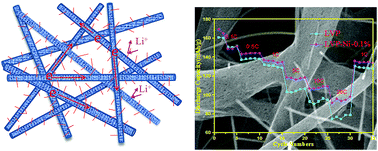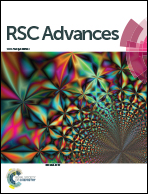Three-dimensional Li3V2(PO4)3/C nanowire and nanofiber hybrid membrane as a self-standing, binder-free cathode for lithium ion batteries†
Abstract
A three-dimensional (3D) mace-like Li3V2(PO4)3/C nanowire and nanofiber hybrid membrane was fabricated by using Ni nanoparticles as a catalyst and a modified electrospinning method followed by a hot-pressing heat treatment. The results indicate that the prepared membrane is composed of Li3V2(PO4)3 nanowires and Li3V2(PO4)3/C composite fibers. This hybrid membrane has a high specific surface area of 227.56 m2 g−1 with a combination of micropores and mesopores, which can be used as self-standing, binder-free cathodes for lithium ion batteries. This hybrid membrane electrode exhibits good rate performance and cyclic stability in the voltage range of 3.0–4.8 V with an initial discharge capacity of 115.3 mA h g−1 at 5C and 108.6 mA h g−1 at 10C and a capacity retention of 81.4% and 75.1% respectively after 500 cycles, 78.8% and 70.3% after 1000 cycles. The coulombic efficiencies both at 5C and 10C maintain about 100% during cycling. This excellent electrochemical performance may be attributed to the unique 3D long-range conductive networks and mace-like fiber structure, which favorably improve the reaction kinetics of Li3V2(PO4)3.


 Please wait while we load your content...
Please wait while we load your content...